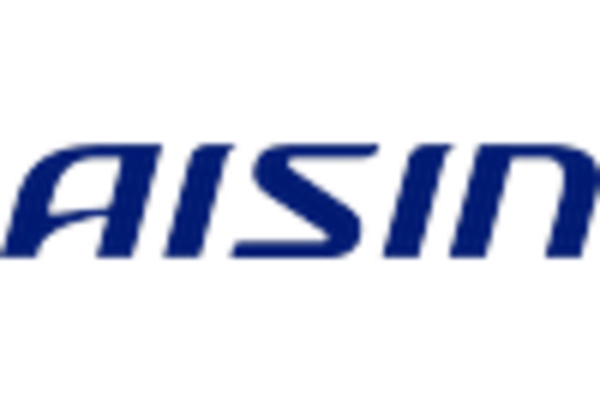Expansion of Electric Vehicle Market
The expansion of the electric vehicle (EV) market is significantly influencing the automotive electronic-brake-system market. As the US government promotes the adoption of EVs through incentives and infrastructure development, the demand for advanced braking systems is expected to rise. Electric vehicles often require specialized braking technologies, such as regenerative braking, which enhances energy efficiency. Reports suggest that by 2025, EV sales in the US could account for over 25% of total vehicle sales. This shift towards electrification is likely to drive investments in electronic brake systems that cater specifically to the needs of electric vehicles, thereby fostering growth in the automotive electronic-brake-system market.
Regulatory Compliance and Safety Standards
The automotive electronic-brake-system market is significantly influenced by stringent regulatory compliance and safety standards imposed by government agencies. In the US, the National Highway Traffic Safety Administration (NHTSA) has established regulations that mandate the implementation of advanced braking technologies in new vehicles. These regulations aim to reduce road accidents and enhance vehicle safety. As a result, automakers are compelled to adopt electronic brake systems that meet these safety standards. The market is projected to grow as manufacturers strive to comply with these regulations, which are expected to become even more rigorous in the coming years. This compliance not only ensures safety but also enhances the reputation of manufacturers in the automotive electronic-brake-system market.
Technological Innovations in Brake System Design
Technological innovations in brake system design are playing a pivotal role in shaping the automotive electronic-brake-system market. The introduction of lightweight materials and advanced sensors has led to the development of more efficient and responsive braking systems. For instance, the use of carbon-ceramic materials is becoming more prevalent, offering improved performance and durability. Additionally, innovations such as regenerative braking systems are gaining traction, particularly in electric and hybrid vehicles. These advancements not only enhance vehicle performance but also contribute to fuel efficiency, making them attractive to consumers. As a result, the automotive electronic-brake-system market is poised for growth as manufacturers continue to innovate and improve their braking technologies.
Growing Demand for Advanced Driver Assistance Systems
The automotive electronic-brake-system market is experiencing a surge in demand due to the increasing integration of Advanced Driver Assistance Systems (ADAS) in vehicles. These systems enhance safety and driving convenience, which is becoming a priority for consumers. As of 2025, it is estimated that nearly 60% of new vehicles in the US will be equipped with some form of ADAS. This trend is likely to drive the adoption of electronic brake systems, as they are essential for the functionality of features such as automatic emergency braking and adaptive cruise control. Consequently, manufacturers are investing heavily in developing sophisticated electronic brake systems that can seamlessly integrate with ADAS, thereby propelling growth in the automotive electronic-brake-system market.
Increasing Consumer Awareness of Vehicle Safety Features
Consumer awareness regarding vehicle safety features is on the rise, which is positively impacting the automotive electronic-brake-system market. As consumers become more informed about the benefits of advanced braking technologies, they are more likely to prioritize vehicles equipped with electronic brake systems. Surveys indicate that approximately 70% of US consumers consider safety features as a critical factor when purchasing a vehicle. This growing awareness is prompting automakers to enhance their offerings, leading to increased investments in electronic brake systems. Consequently, the automotive electronic-brake-system market is likely to expand as manufacturers respond to consumer demand for safer vehicles.

















Leave a Comment